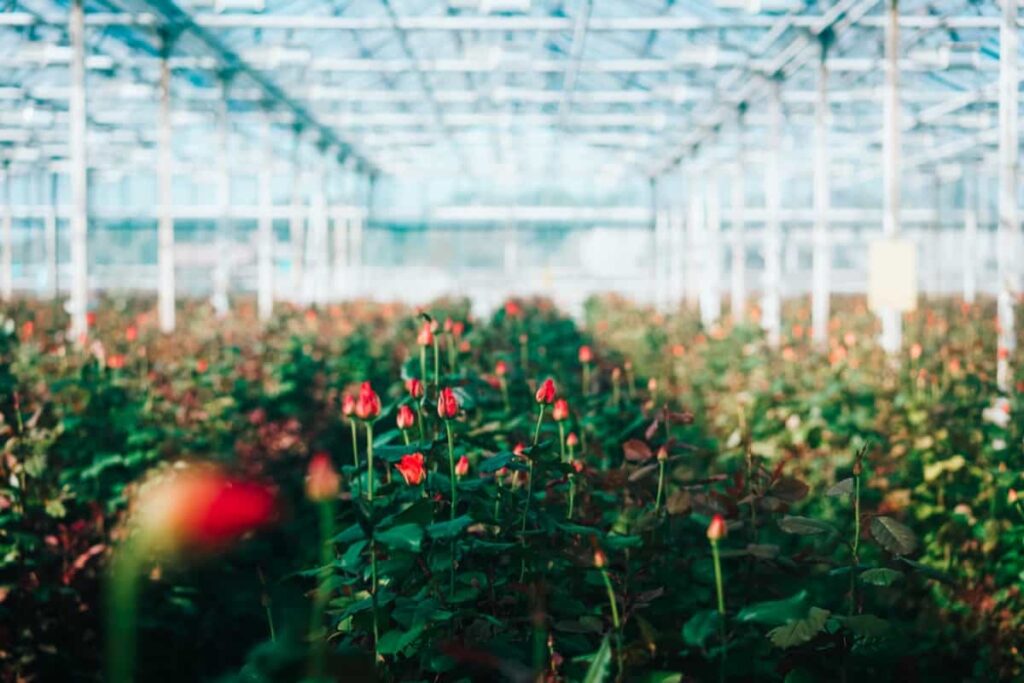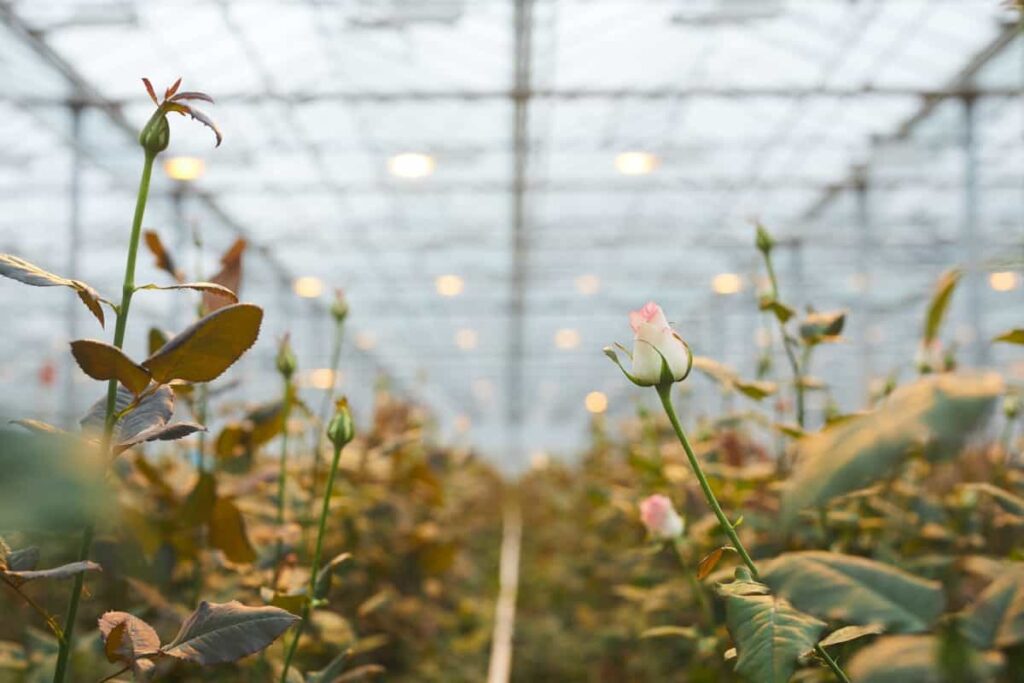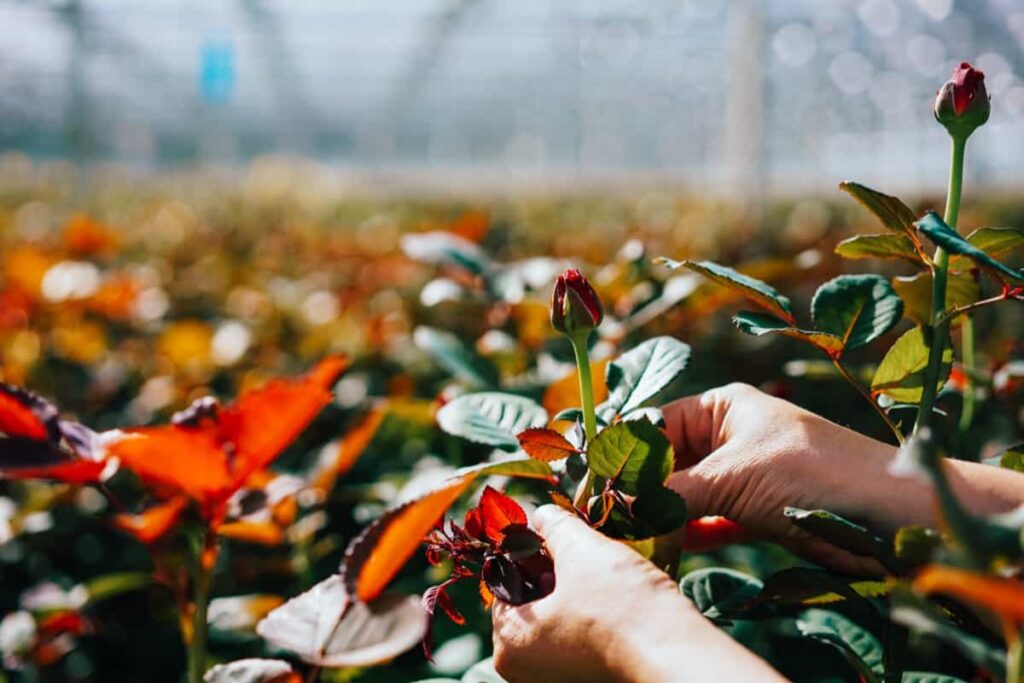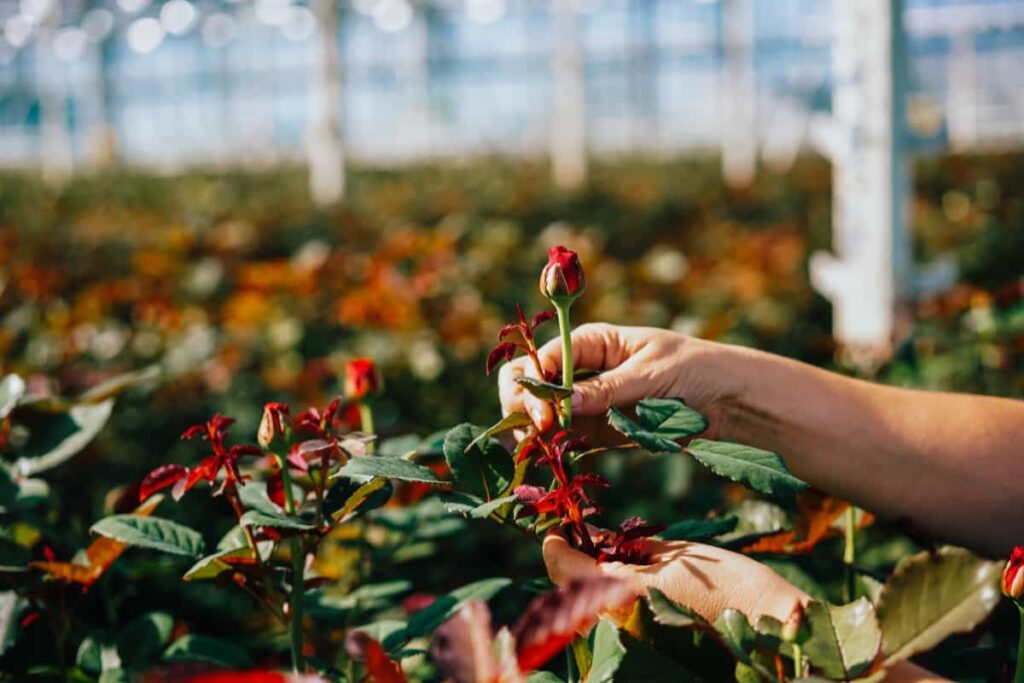Dutch roses are one of the most popular cut flowers in the world, especially for their long stems, large buds, and vibrant colors. They are also known as hybrid tea roses or European roses. They have high demand in both domestic and international markets, especially for occasions like weddings, birthdays, anniversaries, and festivals.

In this article, we will discuss the different aspects of the Dutch rose farming business in India, such as market demand and trends, climatic and soil requirements, best varieties, land preparation and planting techniques, irrigation systems, nutrient management and fertilization practices, pest and disease management, labor requirements and management, cost analysis, revenue generation, profit margin analysis, risk assessment and mitigation strategies, and government policies and subsidies.
Dutch Rose Farming Business in India
What is Dutch Rose Farming?
Dutch rose farming involves the commercial production of cut flowers from Dutch roses or hybrid tea roses. These cut flowers, with long stems and leaves, are of good quality and should be produced in large quantities for a successful business. The cultivation can be done in open fields or polyhouse conditions, with polyhouse cultivation being preferred for better quality and yield. Polyhouses are naturally ventilated structures with a polyethylene covering material, allowing year-round production of Dutch roses without external factors.
Market Demand and Trends for Dutch Roses in India
The demand for Dutch roses in India is increasing due to urbanization, disposable income, lifestyle changes, and consumer awareness. The peak demand season is from October to March, especially during festivals like Diwali, Christmas, New Year, and Valentine’s Day. The total production of Dutch roses in India is around 0.03 thousand metric tonnes, generating 141.45 lakh rupees of income in 2018-19.
In case you missed it: Rosemary Farming Business Plan: A Step-by-Step Guide to Growing and Selling Profitable Herbs

The major producing states are West Bengal, Karnataka, Gujarat, and Chhattisgarh. The average yield of Dutch roses per hectare is around 150-200 MT. The export potential of Dutch roses from India is high due to cheap labor, low production costs, favorable climatic conditions, and proximity to major markets like Europe, the Middle East, and Southeast Asia. India exported 10.5 MT of cut flowers worth 57 crores rupees in 2019-20.
Climatic and Soil Requirements for Dutch Rose Cultivation
Dutch rose cultivation requires a specific temperature range of 20-28°C during daytime and 15-18°C at night, with no temperature exceeding 35°C or below 10°C. Polyhouse cultivation helps maintain these temperatures by using cooling pads or fans during summer and heaters or thermal screens during winter. Humidity should be maintained at 65-75% to prevent fungal diseases and wilting or desiccation of flowers.
Light intensity should be controlled using shade nets or curtains during high-intensity periods and artificial lights or LEDs during low-intensity periods. Carbon dioxide concentration should be 800-1000 ppm to enhance flower growth and yield. Polyhouse cultivation can increase carbon dioxide levels using carbon dioxide generators or cylinders during low-concentration periods. Soil pH should be 6.0-6.5, well-drained, fertile, and rich in organic matter. Improved soil quality can be achieved through raised beds, mulching, and soil sterilization techniques.
Best High-Quality Dutch Rose Varieties for Commercial Production
Growing Dutch roses is a complex task that requires careful planning, proper techniques, and constant care. There are hundreds of varieties available in the market, each with its own characteristics and preferences. However, not all of them are suitable for cultivation in India. To ensure successful cultivation, choose varieties that can adapt to the local climate, resist diseases, and meet market demand.
Some of the best high-quality Dutch rose varieties for commercial production in India include Red Naomi, a popular red rose with large, velvety petals, a strong and sweet fragrance, and a long vase life of up to 14 days. Pink Avalanche, a beautiful pink rose with medium-sized petals, a soft and elegant appearance, a light and fresh fragrance, and a vase life of up to 12 days.
Sweet Avalanche, a stunning white rose with a hint of pink at the edges, has large, lush petals, a subtle and sweet fragrance, and a vase life of up to 10 days. White Naomi, another exquisite white rose, has a large, dense bloom, a rich and spicy fragrance, and a vase life of up to 12 days.
Land Preparation and Planting Techniques for Dutch Roses
To prepare a plant bed for planting, the land should be thoroughly plowed and leveled, and the soil tested for pH, electrical conductivity, organic carbon, nitrogen, phosphorus, and potassium. Organic manures like farmyard manure and vermicompost should be applied at a rate of 20-25 tonnes per hectare, and fungicides like captan or carbendazim should be used to prevent soil-borne diseases.
In case you missed it: Best Drought Tolerant Container Plants for Full Sun and Heat: Evergreen, Perennial, Flowering for Year-round

Planting material should be healthy, disease-free, and true to type, obtained from certified nurseries or tissue culture labs. Stored in a cool, dark place, the material should be dipped in a fungicide solution for 15 minutes before planting. The planting technique depends on the type of polyhouse used, which can be naturally ventilated polyhouse (NVP) or fan and pad polyhouse (FPP). NVP planting involves raised beds, while FPP planting uses benches. The planting density is around ten plants per square meter in both types, and the planting time is from September to November.
Irrigation Systems for Dutch Rose Farming
Dutch rose farming relies heavily on irrigation, which affects plant growth, development, flowering, and quality. The most common irrigation systems include drip irrigation and sprinkler irrigation. Drip irrigation is preferred due to its cost-effectiveness, reducing water, fertilizer, and labor costs and reducing weed growth, soil erosion, and salinity issues.
It delivers water, nutrients directly to the plant’s root zone through emitters or drippers. The frequency and duration of irrigation depend on the plant’s water requirements, such as temperature, humidity, light intensity, and wind speed. Sprinkler irrigation, on the other hand, distributes water uniformly over the crop area and helps maintain humidity.
However, it has disadvantages like water loss due to evaporation and runoff, increased disease incidence, and higher energy consumption. The water should be free from salts, pathogens, and contaminants, with a pH between 5.5 and 6.5 and an electrical conductivity of less than one dS/m. Regular water quality testing and treatment are necessary.
Nutrient Management and Fertilization Practices
Dutch rose farming relies heavily on nutrient management, which impacts the growth, flowering, quality, and shelf life of the flowers. Nutrients are supplied to the plants through soil application or fertigation, which involves adding organic manures or chemical fertilizers to the soil before planting or during cultivation. Organic manures improve soil structure, fertility, water-holding capacity, and microbial activity, while chemical fertilizers provide specific nutrients in soluble forms.
Fertigation, a technique of applying water-soluble fertilizers along with irrigation water through drip or sprinkler systems, is more efficient than soil application and delivers nutrients to the root zone. It reduces leaching losses, nutrient fixation, weed growth, and labor costs. The major nutrients required by Dutch roses include nitrogen, phosphorus, potassium, calcium, magnesium, sulfur, iron, manganese, zinc, copper, boron, molybdenum, and chlorine. The recommended dose of NPK for Dutch roses is 200:100:200 g/plant/year, with other nutrients based on soil and water analysis and plant deficiency symptoms.
Pest and Disease Management in Dutch Rose Cultivation
Pest and disease management is crucial for the health and quality of Dutch roses, as they can significantly impact yield, quality, and income. Common pests include aphids, thrips, whiteflies, spider mites, leaf miners, caterpillars, cutworms, stem borers, and nematodes. Common diseases include powdery mildew, downy mildew, black spot, rust, botrytis blight, bacterial wilt, and root rot.
In case you missed it: Top 10 Best Organic Fertilizers in India: Top Companies for Vegetables, Flowers and Fruit Plants along with Price

To manage pests and diseases in Dutch rose cultivation, preventive measures such as selecting healthy planting material, using disease-free soil, sterilizing tools and equipment, maintaining sanitation, removing weeds, avoiding waterlogging, and regulating temperature and humidity are essential. Regular scouting and monitoring of the crop are also necessary for early detection and identification of pests and diseases. Control measures, such as cultural, mechanical, biological, or chemical methods, are applied to control pests and diseases.
Operational Costs Involved in Dutch Rose Cultivation
Dutch rose cultivation involves various operational costs such as labor wages, electricity, water, maintenance, transportation, and marketing. These costs vary based on the number and skill of workers, the power supply’s consumption and tariff, the water source and quantity used, maintenance costs for polyhouse components and equipment, transportation costs based on the distance to the market, and marketing costs based on commission and fees paid to agents and traders. The annual operational cost for a one-acre polyhouse for Dutch rose cultivation is approximately Rs. 15,00,000.
Revenue Generation from Dutch Rose Sales
Dutch rose sales generate revenue based on the yield and price of the flowers, which are influenced by the variety, quality, and management of the roses. The average yield in a one-acre polyhouse is 200 flowers per square meter per year, allowing for the production of around 80 lakh flowers per year. In India, the average price of Dutch roses is Rs. 4 per flower, generating a revenue of Rs. 3,20,00,000 per year.
Profit Margin Analysis for 1 Acre Dutch Rose Cultivation
The profit margin analysis for one acre of Dutch rose cultivation can be calculated by subtracting the total cost from the total revenue. The total cost for one acre is Rs. 78,00,000, while the total revenue is Rs. 3,20,00,000. Therefore, the profit can be calculated as Rs. 2,42,00,000, resulting in a profit of Rs. 2 crore 42 lakh per year from this cultivation.
Risk Assessment and Mitigation Strategies for Dutch Rose Farmers
Dutch rose farmers face risks like pest and disease attacks, climate changes, market fluctuations, and technical failures that can impact the quality, quantity, and profitability of their flowers. Mitigation strategies include:
- Choosing resistant rose varieties, following cultural practices.
- Applying balanced fertilization and irrigation.
- Implementing integrated pest and disease management.
- Installing backup systems.
- Monitoring environmental conditions.
- Maintaining hygiene and sanitation.
- Adopting post-harvest management.
In case you missed it: Plants Soil pH Chart: Optimal Values for Vegetables, Flowers, Trees, Herbs, and Shrubs

Cost Analysis for Setting Up a Dutch Rose Farm
| Component | Cost (Rs.) |
| Fixed Cost (Polyhouse) | 27,00,000 |
| Variable Cost per Year (Polyhouse) | 13,50,000 |
| Polyhouse Construction (per sq. meter) | 500 |
| Polyhouse Construction (1 acre) | 20,23,500 |
| Planting Material Cost (Polyhouse) | 6,00,000 |
| Drip Irrigation System Cost (Polyhouse) | 1,00,000 |
| Fertilizer and Pesticide Cost (Polyhouse) | 10,000 |
| Labor Cost per Year (Polyhouse) | 9,00,000 |
| Miscellaneous Cost per Year (Polyhouse) | 4,00,000 |
| Total Cost (Polyhouse) | 83,83,500 |
Government Policies and Subsidies for Dutch Rose Farmers in India
The Indian government is promoting floriculture as a profitable agribusiness sector, particularly for small and marginal farmers. Various schemes and policies offer financial assistance, technical guidance, market linkages, and quality standards for flower growers. Major schemes include the National Horticulture Mission (NHM), which provides subsidies for establishing new floriculture units, expanding existing ones, and developing marketing infrastructure. The National Horticulture Board (NHB) offers subsidies for setting up hi-tech greenhouses, polyhouses, and shade nets for controlled flower growth.
The Agricultural Processed Food Products Export Development Authority assists flower growers in registering as exporters, obtaining certification, conducting market surveys, and participating in trade fairs. The Mission for Integrated Development of Horticulture provides subsidies for setting up nurseries, tissue culture labs, and vermicompost units for producing quality planting material. State-specific schemes, such as Krishi Bhagya in Karnataka, also provide additional incentives and benefits for flower growers.
Yield of Dutch Roses per Acre
The yield of Dutch roses per acre is influenced by factors such as the variety, cultivation system, climatic conditions, irrigation, fertilization practices, and pest and disease management. They are typically grown in polyhouses or greenhouses, which provide optimal conditions for growth and flowering. Agri Farming’s project report shows that the average yield in a polyhouse is around 200 stems per square meter per year, equivalent to 8 lakh stems per acre per year.
In case you missed it: How to Grow Marigold at Home in the USA: From Seeds and Cuttings in the Backyard, and Pots

The average selling price of Dutch roses is about Rs. 5 per stem, resulting in a gross income of about Rs. 40 lakh per year. In a greenhouse, the average yield is around 250 stems per square meter per year, equivalent to 10 lakh stems per acre per year. The gross income from one acre of greenhouse Dutch roses is around Rs. 60 lakh per year.
Conclusion
Dutch rose farming in India, covering one acre, involves an estimated total cost of around Rs. 83.83 lakh, considering factors like polyhouse construction, planting material, labor, and miscellaneous expenses. A comprehensive economic analysis indicates the potential for profitable returns with careful management.
- Management Pests and Diseases in Your Cotton Field
- Sheep Farming Business Plan for Beginners
- Aquaponic Farming at Home: A Step-By-Step Guide
- Profitable Village Farming Business Ideas in 2024
- High-Yield Aquaculture: Fast-Growing Fish for Farming
- Effective Fish Pond Construction Techniques for Beginners
- Irrigation and Water Management in Pineapple Farming
- Blossom to Harvest: Mastering Flowering and Pollination in Papaya Farming
- Pig Fattening Essentials: From Selection to Sale for Beginners
- Raising Wagyu Cattle: A Complete Guide for Premium Beef Production
- Soil Types and Their Water Holding Capacity
- Optimizing Irrigation Schedules for Coconut Groves for Enhanced Yield
- Espresso Your Garden: Coffee Grounds for Healthier Acid-Loving Plants
- The Best Soil Mix for Snake Plants: How to Mix Your Own Snake Plant Soil
- Green Thumb Success: Expert Tips for Cultivating Greenhouse Beans All Year Round
- Bloom All Year Round: The Ultimate Guide to Indoor Hyacinth Care
- Eco-Friendly Gardening: How to Make Liquid Fertilizer from Kitchen Waste
- Ultimate Guide to Grow Anise in Pots: Explore Seed Propagation to Harvesting
- Guide to Raising Chester White Pigs: Discover Breed Facts to Growth Management
- Mastering the Elegance: The Ultimate Guide to Weeping Cherry Tree Care, Planting, and Maintenance
- Ultimate Guide to Planting Garlic in Grow Bags: Growing Strategies for Beginners
- How to Fix Spider Plant Leaf-Related Problems: Natural and Organic Remedies
- 10 Reasons Why Your Tulsi Plant is Shedding Leaves: Home Remedies and Solutions
- Optimizing Growth and Yield: The Advantages of Palm Bunch Ash Fertilizer
- Utilizing Neem Oil Extract as a Natural Pesticide for Hydrangea
- From Soil to Harvest: Various Ways in Which Farmers Can Use AI Tools
- Steps to Encourage and Induce Citrus Flowers: A Comprehensive Guide
- How to Fix Snake Plant Leaf-Related Issues: Natural and Organic Remedies
- Transform Your Garden into a Fragrant Oasis with Raat Ki Rani (Night Blooming Jasmine)
- Discover the Ideal Chicken Breeds for Philippine Farms
- How to Create a Poultry Egg Farm Business Plan for Profits
- Grow Lemon Cucumbers Like a Pro: Insider Techniques for Bountiful Yields
- Ultimate Guide to Caring for Your Pink Princess Philodendron: Tips for Thriving Variegation
- Areca Nut Profit Per Acre: Calculating Yield and Cost of Cultivation
- How Kaveri Chicken is Becoming a More Profitable Breed in Indian Backyards
- Transform Your Barn: 9 Steps to Convert a Horse Stall into a Chicken Coop
